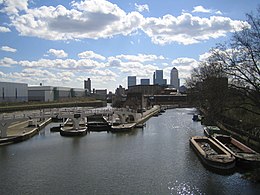Bow Locks

Bow Locks, with Bow Creek, beyond, at low tide. Limehouse Cut begins to the right of the locks.
|
|
| Waterway | River Lee Navigation |
|---|---|
| County |
Tower Hamlets Greater London |
| Maintained by | British Waterways |
| Operation | Mechanical |
| First built | 1850 |
| Latest built | 1930 |
| Length | 95 feet (29.0 m) |
| Width | 19 feet 6 inches (5.94 m) |
| Fall | tidal |
| Distance to Hertford Castle Weir |
28 miles (45.1 km) |
| Coordinates | 51°31′23″N 0°00′29″W / 51.523°N 0.0081°WCoordinates: 51°31′23″N 0°00′29″W / 51.523°N 0.0081°W |
Bow Locks (grid reference TQ383824) (No20) is a set of bi-directional locks in the London Borough of Tower Hamlets. The locks link the tidal Bow Creek to the River Lee Navigation, which is a canalised river. These locks were first built in 1850 and then rebuilt in 1930, at the same time as the Prescott Channel was cut nearby. At high tide, the tide from Bow Creek formerly flowed through Bow Locks, to raise the level of the canals, such as the Limehouse Cut. In 2000, these locks were modified to keep the tide out, to reduce silting in the canal system.
Bow Locks has a long history, as the first recorded mention of a water control structure at the site was during the reign of Edward I, when Henry de Bedyk, the prior at Halliwell Priory and owner of the nearby tide mills. He erected a structure some time before 1307. Despite juries ruling in 1345 and 1362 that it should be removed, it remained in place, and its existence was not contested when commissioners were appointed in 1551. A description of its operation in 1416 indicates that it was similar to a flash lock, consisting of a dam with a navigable channel through it. The channel was 18 feet (5.5 m) wide, and could be closed off using flashboards, to maintain water levels above it.
The owners of the mills rebuilt the structure, referred to as a lock, in 1573. In order to ensure that navigation would be maintained on the Lea, the City of London appointed a Dutch surveyor to inspect the plans, and a committee to oversee the work. A report by Lord Burghley in 1588 suggests that the gates opened automatically when the level in Bow Creek exceeded the level above the lock, and were shut once the tide started to fall. This arrangement caused complaints in 1581, when neap tides did not reach a level to cause the gates to open, and the lock keeper would not open them because the water was used by the mills. The use of flashboards was again recorded in the 1660s, but shortly after 1713, the cill of the structure was raised, and a pair of gates were installed. This improved water levels for the millers, but again caused problems for navigation, with bargees complaining that the gates could not be opened at neap tides. In 1721, the cill was lowered by the mill owners, following recommendations by George Succold, and the work was overseen by a surveyor appointed by the City of London.
...
Wikipedia
